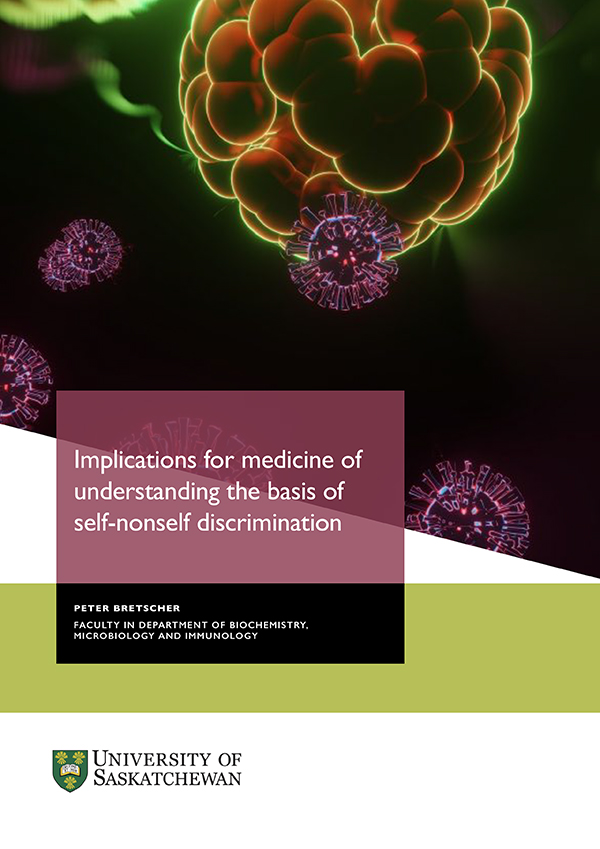Department of Biochemistry – Microbiology and Immunology – University of SaskatchewanCan we now envisage antigen-specific therapies to prevent and treat organ-specific autoimmune diseases, such as autoimmune diabetes?
Mechanisms normally ensuring self-nonself discrimination can fail, leading to organ-specific autoimmunity. In autoimmune diabetes, the self-cells that produce insulin are attacked. Focusing on this disease, I examine here i) circumstances leading to the initiation of organ-specific autoimmunity, ii) the prospects for preventing disease and iii) prospects for treatment.
The framework for our discussion
I sketch for clarity the framework employed, as justified elsewhere. Most anti-self lymphocytes are eliminated as generated in primary lymphoid organs by the mechanism of central tolerance. A minority of self-antigens, such as insulin, are insufficiently present to cause complete central tolerance. Mature lymphocytes specific for peripheral self-antigens, and others specific for foreign antigens, are found in the periphery.
Mature lymphocytes can be activated or inactivated by antigen. The one lymphocyte/multiple lymphocyte model for the antigen dependent inactivation and activation of mature lymphocytes, proposed by Cohn and myself in 1970, explains how peripheral tolerance normally occurs.
Peripheral antigens, such as insulin, are present before mature lymphocytes are generated. Mature lymphocytes specific for insulin are inactivated as generated, one or a few at a time. Lymphocytes specific for a foreign antigen, F, accumulate in its absence; when F impinges upon the immune system it mediates the lymphocyte cooperation needed to generate immunity.
Most agree this model holds for B cells and CD8 T cells: activated Th cells are required for their activation and, in the absence of such help, antigen inactivates these cells. The different circumstances determining whether antigen activates or inactivates CD4 T cells is controversial. I explain in my eBook 2 why I do not favour the popular “danger model” for the activation of CD4 T cells; rather, I propose single CD4 T cells are inactivated by antigen; their activation requires CD4 T cell cooperation mediated by an antigen-specific B cell. This model provides the context for the following considerations.
Circumstances leading to autoimmunity
Our 1970 model accounted both for peripheral tolerance and how autoantibodies can arise. Immunisation of rabbits with bovine thyroglobulin results in some antibodies that bind both rabbit and bovine thyroglobulin. Clearly some B cells specific for both thyroglobulins exist. These B cells can be induced by bovine thyroglobulin, but not by rabbit thyroglobulin, as there are more lymphocytes specific for the foreign than the self-thyroglobulin. Thus, foreign antigens, that cross-react with a peripheral antigen, have the potential for inducing autoimmunity to the peripheral antigen. For example, infection by group A streptococci can lead to inflammatory, autoimmune, rheumatic heart disease. This occurs because these pathogens cross-react with heart tissue. This is evident at both at the level of antibody and CD4 T cells. The activation of cross-reactive CD4 T cells is readily explained if, as I favour, CD4 T cell activation requires CD4 T cell collaboration.
Epitope spreading
Mice belonging to the non-obese diabetic (NOD) strain spontaneously develop lymphocytes specific for self- beta-islet cells that produce insulin. Some mice become ill with autoimmune diabetes. Most interestingly, autoreactive T cells specific for one antigen, the initiating antigen, are detected in mice at three weeks of age. With time, the autoreactive Th cells recognise an increasing number of self-antigens, a phenomenon referred to as epitope spreading, anticipated on the CD4 T cell cooperation model for CD4 T cell activation.
Moreover, intra-thymic exposure of mice to the initiating antigen at one week of age prevents the generation of the CD4 T cells specific for this antigen and of autoimmunity. This antigen exposure presumably results in deletion of CD4 T cells specific for the initiating antigen and so of “epitope spreading”.
Genetics of autoimmune diabetes and the “critical event hypothesis”
The strongest susceptibility gene for diabetes of NOD mice codes for a class II MHC molecule. This fact, the phenomenon of epitope spreading and of its inhibition as just described, leads me to suggest a single, critical event initiates the generation of autoreactive CD4 T cells: the formation of an initiating peptide/MHC complex, where the peptide is derived from the cross-reacting foreign antigen, can activate the first anti-self CD4 T cells and initiate epitope spreading. A similar scenario likely initiates rheumatic heart disease on infection by group A streptococci.

Preventing autoimmune diabetes in genetically susceptible people
It should be possible to determine the initiating peptide in NOD mice. It is technically possible by a screening procedure to determine the initiating peptide that, bound to the MHC of NOD mice, is recognised by the first autoreactive CD4 T cells to appear. In addition, it should be possible to inactivate these CD4 T cells.
About half the peptides bound to surface class II MHC molecules dissociate from (come off) the groove in a day. If groove-binding peptides are sufficiently present, these bind to the empty grooves, that I refer to as decoration from the outside.
Certain peptides, given intravenously to mice, bind to temporarily empty MHC grooves, resulting in the elimination of CD4 T cells whose receptors recognise the resulting peptide/MHC complex. As there are so many decorated antigen presenting cells, the rare CD4 T cells are inactivated on interacting with antigen.
Administrating the initiating peptide to NOD mice, at about 10 days of age, half the way to puberty, may well block the generation of autoreactivity. It is known that the administration of peptides in this fashion can even inactivate activated CD4 T cells.
Most individuals who become diabetic are known to be susceptible for genetic reasons and from the incidence of the disease in relatives. I think it should be possible to prevent autoreactivity from developing by administering the initiating peptide periodically before adolescence, when the disease frequently first becomes evident in those with the disposition.
Autoreactivity does not mean autoimmunity
Many foreign invaders and self-antigens are susceptible to both cell-mediated and antibody-mediated attack. Some foreign invaders, and targets in autoimmunity, are susceptible primarily to cell-mediated immunity. Examples of such foreign invaders are most cancers and the pathogens causing tuberculosis, AIDS and the leishmaniases. An example of self-targets is those of autoimmune diabetes. Those NOD mice primarily displaying antibody-mediated autoreactivity are not “ill”. Another means of prevention/ treatment may be modulating the immune response to a Th2 phenotype.

This work is licensed under Creative Commons Attribution-NonCommercial-NoDerivatives 4.0 International.


